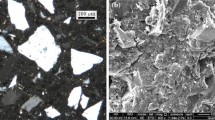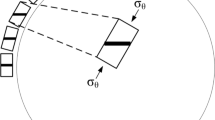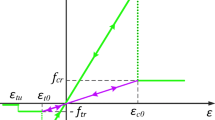Abstract
Existing studies on transversely isotropic rock formations, a special geology, have mainly focused on its mechanical characteristics; whereas, investigations on its fracture process and damage microscopic mechanisms are relatively limited. To remedy this deficiency, in this study, a three-dimensional numerical model is established using discrete elements (PFC3D), focusing on the effects of confining pressure (0, 5, 10, 15, and 20 MPa) and laminar inclination angle (θ0°, θ15°, θ30°, θ45°, θ60°, θ75°, and θ90°) on the failure behavior of the composite rock. To demonstrate the accuracy of the simulations, the stress–strain curves and ultimate failure modes obtained from the numerical simulations were compared with the previous laboratory mechanical test results and X-ray CT images. Numerical models using the smooth-joint contact model were shown to simulate the laboratory results reasonably well. Numerical simulation results indicate that the confining pressure and laminar angle significantly influence the internal crack evolution patterns of the specimen. The internal cracks change from a concentrated to a discrete distribution as the confining pressure increases. The internal cracks of specimens with θ0° and θ90° laminar inclination emerges from the soft rock and eventually extends to the hard rock, while the inclined specimens crack from the laminar face and finally spread to the rock matrix, which can be explained by the graph of the increasing number of cracks. In addition, the internal principal stress and tangential stress in soft and hard rocks were monitored by arranging measurement circles, and it was found that the tangential stresses are the essential cause of the difference between the mechanical behavior of the two rock types.
Highlights
-
The complicated three-dimensional discrete element transversely models captured the prospective mechanical behavior and cracking characteristic
-
The failure patterns and crack coalescence process are characterized by various confining pressure and bedding inclination angles
-
The difference behavior between the soft and hard rock matrix is dependent on the confining pressure and internal tangential stress






















Similar content being viewed by others
Data availability
The data used to support the findings of this study are available from the corresponding author upon request.
References
Ademović N, Kurtović A (2021) Influence of planes of anisotropy on physical and mechanical properties of freshwater limestone (mudstone). Constr Build Mater 268:121174
Cao WK, Liu W (2022) The wellbore stability study in bedding shale formation the condition of plasticity. Chem Technol Fuels Oils 58:220–231
Chen DH, Chen H, Zhang W (2022) An analytical solution of equivalent elastic modulus considering confining stress and its variables sensitivity analysis for fractured rock masses. J Rock Mech Geotech Eng 14:825–836
Cheng JL, Yang SQ, Chen K (2017) Uniaxial experimental study of the acoustic emission and deformation behavior of composite rock based on 3D digital image correlation (DIC). Acta Mech Sin 33(6):999–1021
Cheng JL, Yang SQ, Yin PF (2018) Experimental study of the deformation and strength behavior of composite rock specimens in unloading confining pressure test. J China Univ Min Technol 47:6
Cheng JL, Luo S, Li JB (2020) Triaxial loading test of strength behavior and failure mechanism of composite rock. J Min Safety Eng 37:6
Chiu CC, Wang TT, Weng MC (2013) Modeling the anisotropic behavior of jointed rock mass using a modified smooth-joint model. Int J Rock Mech Min Sci 62:14–22
Cho JW, Kim H, Jeon S (2012) Deformation and strength anisotropy of Asan geniss, Boryeong ahale, and Yeoncheon schist. Int J Rock Mech Min Sci 50:158–169
Deng PH, Liu QS, Huang X (2022) FDEM numerical modeling of failure mechanisms of anisotropic rock masses around deep tunnels. Comput Geotech 142:104535
Ding XB, Zhang LY, Zhu HH (2014) Effect of model scale and particle size distribution on PFC3D simulation results. Rock Mech Rock Eng 47:2139–2156
Dobróka M, Szabó NP, Dobróka TE (2022) Multi-exponential model to describe pressure-dependent P- and S-wave velocities and its use to estimate the crack aspect ratio. J Rock Mech Geotech Eng 14:385–395
Dong ZJ, Yang SQ, Sun BW (2022) Three-dimensional grain-based model study on triaxial mechanical behavior and fracturing mechanism of granite containing a single fissure. Theoret Appl Fract Mech 122:103602
Duan K, Kwok CY (2016) Evolution of Stress-induced borehole breakout in inherently anisotropic rock: insights from discrete element modeling. J Geophys Res 121:2361–2381
Duan K, Kwok CY, Pierce M (2016) Discrete element method modeling of inherently anisotropic rocks under uniaxial compression loading. Int J Numer Anal Meth Geomech 40:1150–1183
Ghazvinian A, Vaneghi RG, Hadei MR (2013) Shear behavior of inherently anisotropic rocks. Int J Rock Mech Min Sci 61:96–110
He JM, Afolagboye LO (2018) Influence of layered orientation and interlayer bonding force on the mechanical behavior of shale under Brazilian test conditions. Acta Mechanica Sinca 34(2):349–358
He R, Ren L, Zhang R (2022) Anisotropy characterization of the elasticity and energy flow of Longmaxi shale under uniaxial compression. Energy Rep 8:1410–1424
Hill R (1950) The mathematical theory of plasticity. Oxford University Press, Oxford
Ivars DM, Pierce ME, Darcel C (2011) The synthetic rock mass approach for jointed rock mass modeling. Int J of Rock Mech Min Sci 48:219–24
Jeager JC (1960) Shear failure of transversely isotropic rock. Geol Mag 97:65–72
Jiang MJ, Yan HB, Zhu HH (2011) Modeling shear behavior and strain localization in cemented sands by two-dimensional distinct element method analyses. Comput Geotech 38:14–29
Lee H, Jeon S (2011) An experimental and numerical study of fracture coalescence in pre-cracked specimens under uniaxial compression. Int J Solids Struct 48:979–999
Liu LW, Li HB, Chen SH (2021) Effects of bedding planes on mechanical characteristics and crack evolution of rocks containing a single pre-existing flaw. Eng Geol 293:106325
Mehranpour MH, Kulatilake PHSW (2017) Improvements for the smooth joint contact model of the particle flow code and its applications. Comput Geotech 87:163–177
Park B, Min KB (2015) Bonded-particle discrete element modeling of mechanical behavior of transversely isotropic rock. Int J Rock Mech Min Sci 76:243–255
Park B, Min KB, Thompson N (2018) Three-dimensional bonded-particle discrete element modeling of mechanical behavior of transversely isotropic rock. Int J Rock Mech Min Sci 110:120–132
Potyondy D O., 2012, Flat-Jointed Bonded-Particle Material for Hard Rock. American Rock Mechanics Association
Potyondy DO (2015) The bonded-particle model as a tool for rock mechanics research and application: current trends and fracture directions. Geosyst Eng 18(1):1–28
Potyondy DO, Cundall PA (2004) A Bonded-particle model for rock. Int J Rock Mech Min Sci 41(8):1329–1364
Read RS, Chandler NA, Dzik EJ (1998) In situ strength criteria for tunnel design in highly-stressed rock masses. Int J Rock Mech Min Sci 35:261–278
Roy DG, Singh TN (2015) Effect of heat treatment and layer orientation on the tensile strength of a crystalline rock under Brazilian test condition. Rock Mech Rock Eng 49(5):1663–1677
Saeidi O, Vaneghi RG, Rasouli V (2013) A modified empirical criterion for strength of transversely anisotropic rocks with metamorphic origin. Bull Eng Geol Env 72(2):257–269
Saeidi O, Rasouli V, Vaneghi RG (2014) A modified failure criterion for transversely isotropic rocks. Geosci Front 5:215–225
Sapari NK, Zabidi H (2019) Determination of strength variation in jointed anisotropic rocks behavior using UCS and Brazilian tensile test. Mater Today Proc 17:905–911
Shen PW, Tang HM, Zhang B (2021) Investigation on the fracture and mechanical behaviors of simulated transversely isotropic rock made of two interbedded materials. Eng Geol 286:106058
Shi XC, Yang X, Meng YF (2016) An anisotropic strength model for layered rocks considering planes of weakness. Rock Mech Rock Eng 49(9):3783–3792
Singh M, Samadhiya NK, Kumar A (2015) A nonlinear criterion for triaxial strength of inherently anisotropic rocks. Rock Mech Rock Eng 48(4):1387–1405
Sun BW, Yang SQ, Xu J (2022) Discrete element simulation on failure mechanical behavior of transversely isotropic shale under two kinds of unloading paths. Theoret Appl Fract Mech 121:103466
Tien YM, Tsao PF (2000) Preparation and mechanical properties of artificial transversely isotropic rock. Int J Rock Mech Min Sci 37:1001–1012
Tsai SW, Wu E (1971) A general theory of strength of anisotropic materials. J Compos Mater 5:58
Valente S, Fidelibus C, Loew S (2012) Analysis of fracture mechanics tests on opalinus clay. Rock Mech Rock Eng 45(5):767–779
Vervoort A, Min KB, Konietzky H (2014) Failure of transversely isotropic rock under Brazilian test conditions. Int J Rock Mech Min Sci 70:343–352
Wang J, Xie LZ, Xie HP (2016) Effect of layer orientation on acoustic emission characteristics of anisotropic shale in Brazilian tests. J Nat Gas Sci Eng 36:1120–1129
Wang ZH, Wang M, Zhou L (2022) Research on uniaxial compression strength and failure properties of stratified rock mass. Theoret Appl Fract Mech 121:103499
Weng MC, Wu PL, Fang CH (2022) Evaluating the effect of anisotropy on hydraulic stimulation in a slate geothermal reservoir. Rock Mech Rock Eng. https://doi.org/10.1007/s00603-022-03020-5
Yang SQ, Yin PF, Huang YH (2019a) Experiment and discrete element modeling on strength, deformation and failure behavior of shale under brazilian compression. Rock Mech Rock Eng 52(11):4339–4359
Yang SQ, Yin PF, Huang YH (2019b) Strength, deformability and X-ray micro-CT observations of transversely isotropic composite rock under different confining pressures. Eng Fract Mech 214:1–20
Yang SQ, Yin PF, Li B (2020) Behavior of transversely isotropic shale observed in triaxial tests and Brazilian disc tests. Int J Rock Mech Min Sci 133:104435
Yin PF, Yang SQ (2018) Experimental investigation of the strength and failure behavior of layered sandstone under uniaxial compression and Brazilian testing. Acta Geophys 66(4):585–605
Yin PF, Yang SQ, Tian WL (2019) Discrete element simulation on failure mechanical behavior of transversely isotropic rocks under different confining pressure. Arab J Geosci. https://doi.org/10.1007/s12517-019-4807-0
Zhang JC (2013) Borehole stability analysis accounting for anisotropies in drilling to weak bedding planes. Int J Rock Mech Min Sci 60:160–170
Zhang YL, Shao JF, Saxcé GD (2019) Study of deformation and failure in an anisotropic rock with a three-dimensional discrete element model. Int J Rock Mech Min Sci 120:17–28
Acknowledgements
This research was supported by the National Natural Science Foundation of China (42077231) and the Fundamental Research Funds for the Central Universities (2021ZDPYJQ002).
Author information
Authors and Affiliations
Corresponding author
Ethics declarations
Conflict of interest
The authors declare that they have no conflict of interests.
Additional information
Publisher's Note
Springer Nature remains neutral with regard to jurisdictional claims in published maps and institutional affiliations.
Rights and permissions
Springer Nature or its licensor (e.g. a society or other partner) holds exclusive rights to this article under a publishing agreement with the author(s) or other rightsholder(s); author self-archiving of the accepted manuscript version of this article is solely governed by the terms of such publishing agreement and applicable law.
About this article
Cite this article
Song, Y., Yang, SQ., Li, KS. et al. Mechanical Behavior and Fracture Evolution Mechanism of Composite Rock Under Triaxial Compression: Insights from Three-Dimensional DEM Modeling. Rock Mech Rock Eng 56, 7673–7699 (2023). https://doi.org/10.1007/s00603-023-03443-8
Received:
Accepted:
Published:
Issue Date:
DOI: https://doi.org/10.1007/s00603-023-03443-8




